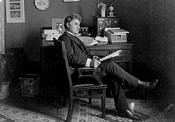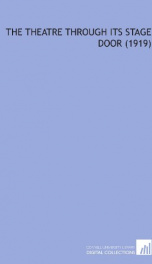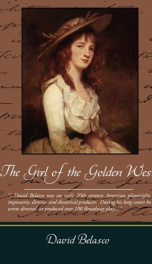Belasco David

David Belasco (July 25, 1853 – May 14, 1931) was an American playwright, impresario, director and theatrical producer. Born in San Francisco, California, where his Sephardic Jewish parents had moved from London, England during the Gold Rush, he began working in a San Francisco theatre doing a variety of routine jobs such as call boy and script copier. He eventually was given the opportunity to act and serve as a stage manager, learning the business inside out. A gifted playwright, Belasco went to New York City in 1882 where he worked as stage manager for the Madison Square Theater while writing plays. By 1895, he was so successful that he set himself up as an independent producer. During his long career between 1884 and 1930, Belasco either wrote, directed, or produced more than 100 Broadway plays including Hearts of Oak, The Heart of Maryland, and Du Barry, making him the most powerful personality on the New York city theater scene. Although he is perhaps most famous for having penned Madame Butterfly and The Girl of the Golden West for the stage, both of which were adapted as operas by Giacomo Puccini, more than forty motion pictures have been made from the many plays he authored, including Buster Keaton's Seven Chances. Belasco was informally known in the theatrical community as "the Bishop of Broadway," due to his penchant for dressing in black clothing which made him resemble a priest. He was also rumored to have used, or even originated, the casting couch . Belasco was mentioned as a contemporary celebrity in Henry Miller's Tropic of Capricorn. In The Great Gatsby by F. Scott Fitzgerald, chapter III, page 50, Nick encounters "Owl Eyes," who says of Gatsby "[T]his fella's a regular Belasco," in reference to his giant (apparently just for-show) library. Many prominent performers of the late 1800s and early 1900s sought the opportunity to work with Belasco; among them was a young Mary Pickford. Pickford appeared in his plays The Warrens of Virginia at the first Belasco Theatre in 1907 and A Good Little Devil in 1913. The two remained in touch after Pickford began working in Hollywood; Belasco appeared with her in the 1914 film adaptation of A Good Little Devil. He is also credited as giving Pickford her stage name. David Belasco was married to Cecilia Loverich for over fifty years; they had two daughters, Reina and Augusta. He died in 1931 at the age of 77 in New York City and was interred in the Linden Hills Jewish Cemetery in Queens, New York. Findagrave incorrectly lists Belasco as buried in the nearby Linden Hills "Methodist" Cemetery. Belasco is recognized for bringing a new standard of naturalism to the American stage. Supposedly he put appropriate scents to set scenes in the ventilation of the theaters, while his sets paid great attention to detail, and sometimes spilled out into the audience area. In one play, for instance, an operational laundromat was built onstage. In The Governor's Lady, there was a reproduction of a Childs Restaurant kitchen where actors actually cooked and prepared food during the play. He is even said to have purchased a room in a flop-house, cut it out of the building, brought it to his theater, cut out one wall and presented it as the set for a production. Belasco's original scripts were often filled with long, specific descriptions of props and set dressings. Interestingly, though, he has not been noted for producing unusually naturalistic scenarios. Belasco was further known for his advanced lighting techniques and use of color to evoke mood and setting. He was one of the first directors to eschew the use of footlights in favor of follow spots and realistic lighting. Often, Belasco tailored his lighting configurations to compliment the complexions and hair of the actors. In his own theatres, the dressing rooms were equipped with lamps of several colors, allowing the performers to see how their makeup looked under different lighting conditions. Belasco also embraced existing theatre technology and sought to expand on it. Both of Belasco's New York theatres were built on the cutting edge of their era's technology. When Belasco took over the Republic Theatre he drilled a new basement level to accommodate his machinery; the Stuyvesant Theatre was specially constructed with enormous amounts of flyspace, hydraulics systems and lighting rigs. The basement of the Stuyvesant contained a working machine shop, where Belasco and his team experimented with lighting and other special effects. Many of the innovations developed in the Belasco shop were sold to other producers. The first Belasco Theatre in New York was located at 229 West 42nd Street, between 7th and 8th Avenues, in the Times Square district of Manhattan. Belasco took over management of the theater and completely remodeled it in 1902, only two years after it was constructed as the Theatre Republic by Oscar Hammerstein (the grandfather of the famous lyricist). He gave up the theater in 1910 and it was renamed the Republic. Under various different owners, it went through a tumultuous period as a burlesque venue, hosted second-run and, eventually, pornographic films and fell into a period of neglect before being rehabilitated and reopened as the New Victory Theatre in 1995. The second Belasco Theatre is located at 111 West 44th Street, between 6th and 7th Avenues, only a few blocks away from the New Victory. It was constructed in 1907 as the Stuyvesant Theatre and renamed after Belasco in 1910. The theater was built to Belasco's wishes, with Tiffany lighting and ceiling panels, rich woodwork and murals. His business office and private apartment were also housed there. The Belasco is still in operation as a Broadway venue with much of the original decor still intact. Belasco Theatres also existed in several other cities. The Los Angeles Belasco was built in 1926, is located at 1050 S. Hill St downtown and has been used as a church in recent years. The Shubert-Belasco Theatre, purchased by Belasco in September 1905, was located in Washington D.C. Orignially built in 1895 as the Lafayette Square Opera House, at 17 Madison Place, across from the White House, the theater was razed in 1962 and replaced by the U.S. Court of Claims building.[1]
do you like this author?
What readers are saying
What do you think? Write your own comment on this book!
write a commentWhat readers are saying
What do you think? Write your own comment on this author!
write a commentBook list

The Return of Peter GrimmNovelised From the Play
Series:
Unknown
Year:
Unknown
Raiting:
4.5/5
Show more
add to favoritesadd In favorites

the theatre through its stage door
Series:
Unknown
Year:
Unknown
Raiting:
2.5/5
Originally published in 1919. This volume from the Cornell University Library's print collections was scanned on an APT BookScan and converted to JPG 2000 format by Kirtas Technologies. All titles scanned cover to cover and pages may include marks notations and other marginalia present in the original volume.
Show more
add to favoritesadd In favorites

The Return of Peter Grimm
Series:
Unknown
Year:
Unknown
Raiting:
5/5
CHAPTER PAGE I A MAN AND A MAID 3 II THE HEIR 19 III PETER GRIMM HAS A PLAN 37 IV A WARNING AND A THEORY 56 V A QUEER COMPACT 77 VI BREAKING THE NEWS 99 VII THE HAND RELAXES 108 VIII AFTERWARD 118 IX THE EVE OF A WEDDING 125 X A WASTED PLEA 134 XI THE LEGACIES 149 XII MOSTLY CONCERNING GRATITUDE 157 XIII THE RETURN 164 XIV "I CAN'T GET IT ACROSS" 184 XV A HALF-HEARD MESSAGE 209 XVI THE "SENSITIVE" 231 XVII MR. BATHOLOMMEY TESTIFIES 254 XVIII DR. MCPHERSON'S STATEMENT 265 XIX BACK TO THE STORY 278 XX THE BENEFIT OF THE DOUBT 290 XXI "ONLY ONE THING REALLY COUNTS" 302 XXII "ALL THAT HAPPENS, HAPPENS AGAIN" 313 XXIII THE DAWNING 324 XXIV THE GOOD-BYE 337 --This text refers to the Kindle Edition edition.
Show more
add to favoritesadd In favorites
Book list

The Return of Peter GrimmNovelised From the Play
Series:
Unknown
Year:
Unknown
Raiting:
4.5/5
Show more
add to favoritesadd In favorites

the theatre through its stage door
Series:
Unknown
Year:
Unknown
Raiting:
2.5/5
Originally published in 1919. This volume from the Cornell University Library's print collections was scanned on an APT BookScan and converted to JPG 2000 format by Kirtas Technologies. All titles scanned cover to cover and pages may include marks notations and other marginalia present in the original volume.
Show more
add to favoritesadd In favorites

The Return of Peter Grimm
Series:
Unknown
Year:
Unknown
Raiting:
5/5
CHAPTER PAGE I A MAN AND A MAID 3 II THE HEIR 19 III PETER GRIMM HAS A PLAN 37 IV A WARNING AND A THEORY 56 V A QUEER COMPACT 77 VI BREAKING THE NEWS 99 VII THE HAND RELAXES 108 VIII AFTERWARD 118 IX THE EVE OF A WEDDING 125 X A WASTED PLEA 134 XI THE LEGACIES 149 XII MOSTLY CONCERNING GRATITUDE 157 XIII THE RETURN 164 XIV "I CAN'T GET IT ACROSS" 184 XV A HALF-HEARD MESSAGE 209 XVI THE "SENSITIVE" 231 XVII MR. BATHOLOMMEY TESTIFIES 254 XVIII DR. MCPHERSON'S STATEMENT 265 XIX BACK TO THE STORY 278 XX THE BENEFIT OF THE DOUBT 290 XXI "ONLY ONE THING REALLY COUNTS" 302 XXII "ALL THAT HAPPENS, HAPPENS AGAIN" 313 XXIII THE DAWNING 324 XXIV THE GOOD-BYE 337 --This text refers to the Kindle Edition edition.
Show more
add to favoritesadd In favorites

The Girl of the Golden West
Series:
Unknown
Year:
Unknown
Raiting:
2/5
A work of an American playwright, impresario, director and theatrical producer David Belasco. “The Girl of the Golden West”, published in 1905, is a frontier romance, a popular western drama, telling a story of the Polka Saloon owner. Later the play was made into a popular opera by Puccini. Belasco is considered to be the author of nearly 400 plays, most of them written or adapted by himself; but his writing, in a time when lbsen, Strindberg, and Chekhov were introducing realism, remained filled with sensational melodrama or maudlin sentiment.
Show more
add to favoritesadd In favorites
What readers are saying
What do you think? Write your own comment on this author!
write a commentif you like Belasco David try:
readers also enjoyed
What readers are saying
What do you think? Write your own comment on this author!
write a commentGenre
if you like Belasco David try:
readers also enjoyed
Do you want to read a book that interests you? It’s EASY!
Create an account and send a request for reading to other users on the Webpage of the book!

